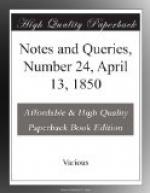Other conspicuous portraits are those of THOMAS BRADBURY, ISAAC WATTS, and SAMUEL CHANDLER. The date of the composition must be placed between 1704 and 1748, but I have to solicit information as to who was its author.
2. Has there been preserved, in print or manuscript, verses which circulated from about 1782-1784, on the same body of men, as characterised, severally, by productions of the vegetable world, and, in particular, by flowers? The bouquet is curious, nor ill-selected and arranged. One individual, for example, finds his emblem in a sweet-briar; another, in a hollyhock; and a third, in a tulip. RICHARD WINTER, JAMES JOUYCE, HUGH WASHINGTON, are parts of the fragrant, yet somewhat thorny and flaunting nosegay. These intimations of it may perhaps aid recollection, and lead to the wished-for disclosure. It came from the hand, and seemed to indicate at least the theological partialities of the lady[1] who culled and bound together the various portions of the wreath.
W.
[Footnote 1: A daughter of the late Joseph Shrimpton, Esq., of High Wycombe.]
Dutch Language.—“E. VEE” will be indebted to “ROTTERODAMUS,” or any other correspondent, who can point out to him the best modern books for acquiring a knowledge of the Dutch language,—an Anglo-Dutch Grammar and Dictionary.
Horns.—1. Why is Moses represented in statues with horns? The idea is not, I think, taken from the Bible.
2. What is the reason for assigning horns to a river, as in the “Tauriformis Aufidus.”
3. What is the origin of the expression “to give a man horns,” for grossly dishonouring him? It is met with in late Greek.
L.C.
Cambridge, March 27.
Marylebone Gardens.—In what year did Marylebone Gardens finally close?
NASO.
Toom Shawn Cattie.—I find these words (Gaelic, I believe, from Tom John Gattie) in an old Diary, followed by certain hieroglyphics, wherewith I was wont to express “recommended for perusal.” I have lost all trace of the recommender, and have hunted in vain through many a circulating library list for the name, which I believe to be that of some book or song illustrating the domestic life of our Western Highlanders. Can any of your readers assist me in deciphering my own note?
MELANION.
Love’s Last Shift.—In the first edition of Peignot’s Manuel du Biblioplide, published in 1800, the title of Congreve’s “Mourning Bride” is rendered “L’Epouse du Matin.” Can any of your readers inform me whether it is in the same work that the title of “Love’s Last Shift” is translated by “Le dernier Chemise de l’Amour?” if not, in what other book is it?
H.C. DE ST. CROIX.
Cheshire-round.—“W.P.A.” asks the meaning of the above phrase, and where it is described.




